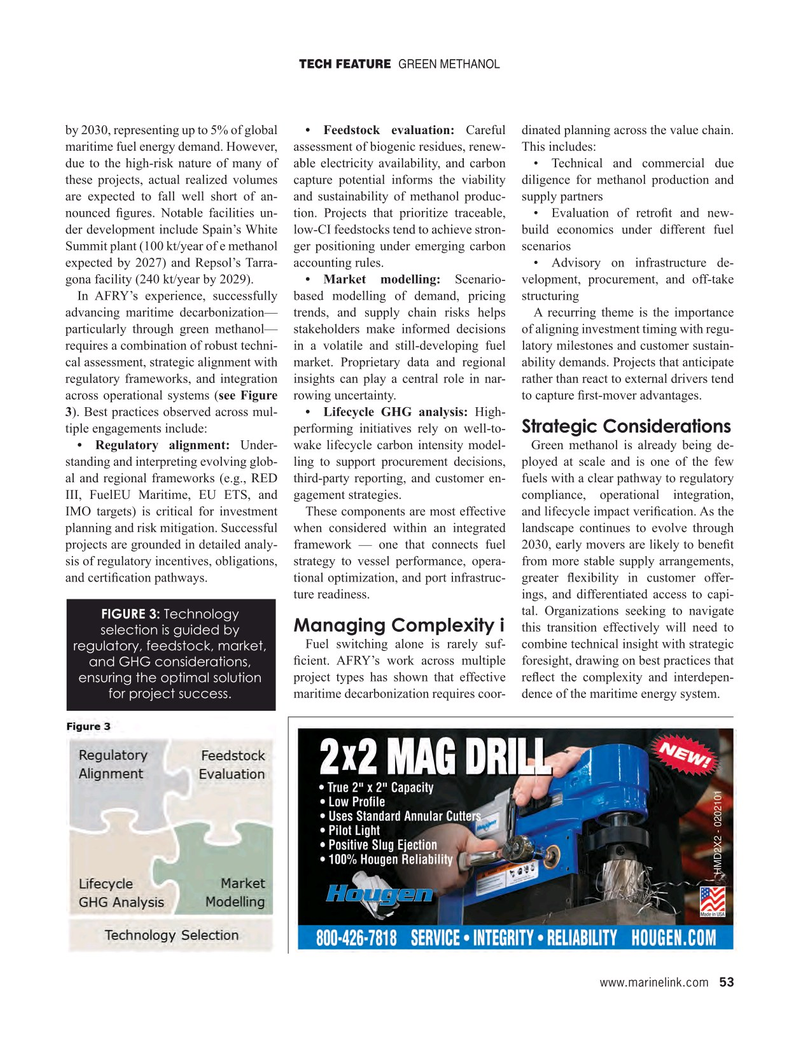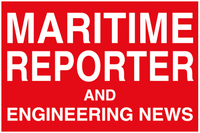
Page 53: of Maritime Reporter Magazine (August 2025)
Read this page in Pdf, Flash or Html5 edition of August 2025 Maritime Reporter Magazine
TECH FEATURE GREEN METHANOL by 2030, representing up to 5% of global • Feedstock evaluation: Careful dinated planning across the value chain. maritime fuel energy demand. However, assessment of biogenic residues, renew- This includes: due to the high-risk nature of many of able electricity availability, and carbon • Technical and commercial due these projects, actual realized volumes capture potential informs the viability diligence for methanol production and are expected to fall well short of an- and sustainability of methanol produc- supply partners nounced ? gures. Notable facilities un- tion. Projects that prioritize traceable, • Evaluation of retro? t and new- der development include Spain’s White low-CI feedstocks tend to achieve stron- build economics under different fuel
Summit plant (100 kt/year of e methanol ger positioning under emerging carbon scenarios expected by 2027) and Repsol’s Tarra- accounting rules. • Advisory on infrastructure de- gona facility (240 kt/year by 2029). • Market modelling: Scenario- velopment, procurement, and off-take
In AFRY’s experience, successfully based modelling of demand, pricing structuring advancing maritime decarbonization— trends, and supply chain risks helps A recurring theme is the importance particularly through green methanol— stakeholders make informed decisions of aligning investment timing with regu- requires a combination of robust techni- in a volatile and still-developing fuel latory milestones and customer sustain- cal assessment, strategic alignment with market. Proprietary data and regional ability demands. Projects that anticipate regulatory frameworks, and integration insights can play a central role in nar- rather than react to external drivers tend across operational systems (see Figure rowing uncertainty. to capture ? rst-mover advantages.
3). Best practices observed across mul- • Lifecycle GHG analysis: High-
Strategic Considerations tiple engagements include: performing initiatives rely on well-to- • Regulatory alignment: Under- wake lifecycle carbon intensity model- Green methanol is already being de- standing and interpreting evolving glob- ling to support procurement decisions, ployed at scale and is one of the few al and regional frameworks (e.g., RED third-party reporting, and customer en- fuels with a clear pathway to regulatory
III, FuelEU Maritime, EU ETS, and gagement strategies. compliance, operational integration,
IMO targets) is critical for investment These components are most effective and lifecycle impact veri? cation. As the planning and risk mitigation. Successful when considered within an integrated landscape continues to evolve through projects are grounded in detailed analy- framework — one that connects fuel 2030, early movers are likely to bene? t sis of regulatory incentives, obligations, strategy to vessel performance, opera- from more stable supply arrangements, and certi? cation pathways. tional optimization, and port infrastruc- greater ? exibility in customer offer- ture readiness. ings, and differentiated access to capi- tal. Organizations seeking to navigate
FIGURE 3: Technology
Managing Complexity i this transition effectively will need to selection is guided by
Fuel switching alone is rarely suf- combine technical insight with strategic regulatory, feedstock, market, ? cient. AFRY’s work across multiple foresight, drawing on best practices that and GHG considerations, ensuring the optimal solution project types has shown that effective re? ect the complexity and interdepen- for project success. maritime decarbonization requires coor- dence of the maritime energy system.
www.marinelink.com 53
MR #8 (50-61).indd 53 MR #8 (50-61).indd 53 8/1/2025 4:51:02 PM8/1/2025 4:51:02 PM

 52
52

 54
54
